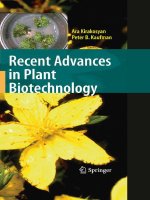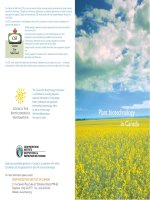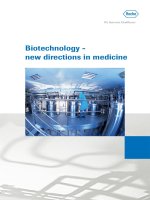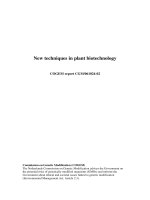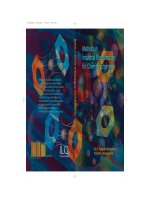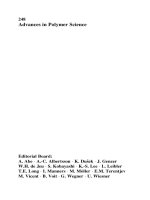New techniques in plant biotechnology
Bạn đang xem bản rút gọn của tài liệu. Xem và tải ngay bản đầy đủ của tài liệu tại đây (109.52 KB, 40 trang )
New techniques in plant biotechnology
COGEM report CGM/061024-02
Commission on Genetic Modification (COGEM)
The Netherlands Commission on Genetic Modification advises the Government on
the potential risks of genetically modified organisms (GMOs) and informs the
Government about ethical and societal issues linked to genetic modification
(Environmental Management Act, Article 2.3).
COGEM report CGM/061024-02
2
New techniques in biotechnology
3
COGEM report CGM/061024-02
4
Summary
Biotechnology offers great opportunities for plant breeding. New techniques for
rapidly selecting or inducing the desired characteristics are being developed.
The Dutch plant breeding sector remains aloof from genetic modification in
plants. The aversion of the consumer, complicated legislation and the high costs
of introducing GM crops and their products do not make genetic modification
an attractive alternative to conventional breeding methods. Nonetheless, with
the advance of technology, the distinction between genetic modification and
other plant biotechnological techniques gradually blurs. In addition, such
technological developments also outgrow the GMO legislation. At times it is not
clear whether the products of some techniques are subject to the prevailing
GMO legislation.
Consequently, an impasse has arisen between the Dutch government and
breeding companies as the developer of new techniques in plant biotechnology.
Companies are only prepared to further develop some innovations when it is
clear whether they are subject to the GMO legislation or not. Being bound by
EU legislation, the government says it can only make this judgement when an
actual application is submitted. Thus a situation is created in which both parties
are waiting for each other.
Advice
This advisory report, which to some degree has a informative character,
discusses six new techniques: ‘reverse breeding’, agroinoculation, grafting on
genetically modified rootstock, gene silencing by DNA methylation, the use of
oligonucleotides, and specific mutagenesis with homologous recombination.
These techniques were chosen as they are either in the early stages of
commercial application or give insight into the problem at stake. For some of
the discussed techniques, the important questions are whether they can be
considered genetic modification and whether their products must be
characterised as GMOs. In this respect, a progressive scale can be distinguished.
The products of some techniques, such as the offspring in case of reverse
breeding, do not contain any novel characteristics, added sequences, mutations
or other changes. In epigenetic mutants, no sequence changes are made in the
genome, though there are heritable effects. In products of grafting, transgenic
sequences may be absent but transgenic proteins or other transgenic molecules
or induced effects can be present. Other products, for instance those generated
by the application of mutagentia coupled with oligonucleotides, do contain
mutations in the genome but that production method is similar to that of
organisms exempted from the legislation. Finally, some organisms are
New techniques in biotechnology
5
genetically modified but by a modification technique that dismisses many of the
current technical-scientific objections.
The European legislation is based on the principle that when recombinant DNA
techniques are used in the production of an organism, this organism is
considered a GMO with changed genetic characteristics. Therefore this
organism is subject to the GMO legislation. The underlying idea here is that the
process of genetic modification is inherently unsafe and associated with risks.
However, with the advance of science and biotechnology, is has become
possible to use recombinant DNA techniques or genetic modification in a
production process, in such a way that the resulting plant or organism does not
contain any added sequences or expresses other changes. An example of this are
plants that are produced with the help of reverse breeding. Based on technical-
scientific grounds COGEM is of the opinion that such plants should not be seen
as GMOs. If current legislation implies this is not possible, COGEM
recommends that they be exempt from GMO legislation.
COGEM considers further the offspring of agroinoculated plants in principle
not as GMOs. However, at this moment it cannot entirely be excluded that this
offspring possesses unintended transgenic sequences after agroinoculation.
COGEM will conduct further research into this. Expectations are that the results
of this research will be made available at the start of 2007.
As yet it is too early for a judgement on epigenetic applications and possibly
related environmental risks. The stability of epigenetic changes and the
underlying mechanism of heredity are unclear at this moment. Applications are
not immediately expected. Furthermore, it is uncertain whether epigenetic
mutants fall within the legal scope of GMO legislation.
Whether non-modified upper stem grafted on GM rootstock and their
products must be subject to the GMO legislation is principally a legal and
political question. However, COGEM observes that it cannot be said that there
are by definition no risks to people and the environment from the upper stem
(products) grafted on GM rootstock and COGEM recommends a case by case
approach.
COGEM considers specific mutagenesis with oligonucleotides a form of
‘traditional’ mutagenesis. It should therefore be exempt from GMO legislation
and regulations.
Targeted integration of transgenes in plants via homologous recombination
falls under the denominator of genetic modification. Plants that are produced
with this technique must be considered as transgene. This implies, under the
current legislation, that an environmental risk analysis will always have to be
performed when a transgene is thus inserted.
COGEM report CGM/061024-02
6
Informative report
COGEM has observed that the development of new techniques demands greater
clarity and perhaps also new interpretations of the current legislation and
regulations regarding GMOs. The dividing line between what is a GMO and
what is not is becoming increasingly more difficult to determine. Whether
certain techniques are subject to the GMO legislation or not is principally a
legal-political choice. Besides the technical-scientific arguments, social-ethical
aspects can also play a role in this.
COGEM emphasises the economic importance of taking policy decisions in
good time in connection with new techniques in biotechnology, as the decision
as to whether certain techniques are subject to the legislation or not has
important economic consequences.
COGEM is conscious of the European character of the legislation and
regulations regarding GMOs and of the guarantee of co-existence and freedom
of choice. Account must be taken of this European dimension when deciding
whether to accommodate the new techniques under the GMO legislation or not.
COGEM points out that new technical developments complicate the
enforcement of the European GMO legislation. As regards import, it will
become increasingly difficult to detect mixing with non-registered GMOs. This
shall raise the question of how the freedom of choice of the consumer can be
guaranteed and whether the mandatory labelling of GMOs sufficiently
guarantees this.
In its recent monitoring
1
on the ethical and social aspects of cisgenesis,
COGEM has listed economic as well as other points of interest in case the
government chooses to create possibilities for simplified admission procedures.
These points of interest can also be important for deciding whether new
techniques and their products are subject to the GMO legislation. COGEM
points out that its advice to not accommodate some techniques under the GMO
legislation is based on technical-scientific grounds. Not all in society will share
this opinion. They may believe their freedom of choice to be limited if products,
for which such techniques were used in the production process, are not
designated as GMOs. This reasoning is strongly held in organic farming, which
aspires to a process-driven and controlled form of agriculture. It is still unclear
what the position and opinion of the consumer is. In deciding whether the
products of certain techniques are subject to the GMO legislation or not, one
point of consideration may be what the consumer expects with respect to
labelling and the like. A consumer survey would perhaps provide more clarity
on this.
New techniques in biotechnology
7
Contents
1. Introduction 9
2. Legislation and regulations 11
3. Reverse Breeding 13
4. Agroinoculation 15
5. Gene silencing by DNA methylation 17
6. Grafting on genetically modified rootstock 21
7. Oligonucleotides 25
8. Targeted mutagenesis with homologous recombination 27
9. Conclusions 31
References 39
COGEM report CGM/061024-02
8
New techniques in biotechnology
9
1. Introduction
In selective plant breeding, varieties of plants are grown and selected which
have the desired characteristics. These characteristics vary greatly from a higher
yield or reduced sensitivity to disease and pests to improved product quality. To
achieve this, the plants are crossed with each other and their progeny tested to
see if they perform better than existing varieties. Plant breeding is a lengthy
process. The time required from hybridisation to the introduction of a new
variety is at least eight to ten years.
Biotechnology has given plant breeding an enormous boost. By applying
new techniques originating from biotechnology, plant breeding has changed
immensely over recent decades. Not having, for example, genetic markers for
selection is unimaginable.
Genetic modification is only a small part of biotechnology. The stringent
legislation, the high costs associated with compiling GMO acceptance files and
the aversion of European consumers to genetically modified food are the
reasons why Dutch breeding companies have little interest in genetic
modification techniques. They sooner focus on techniques that make traditional
breeding processes more efficient. However, some of these techniques are found
at the cutting edge of what can and cannot be considered as genetic
modification.
With this report, COGEM wants to bring the recent technical developments in
biotechnology to the attention of the government. The commission wants to
provide an insight into the current state of affairs in this field by offering insight
into the possible applications of certain techniques, any risks and ambiguities in
the legislation.
This report discusses six more or less new applications that will reach the
commercial stage of application within the near future. For these applications, a
sliding scale is discernible ranging from products that are clearly not transgenic
because they contain no additions, changes or mutations in the genome, or
changed properties, to plants that are clearly genetically modified. However,
each of these new techniques raises questions on the interpretation of the GMO
legislation. The answers to these questions are essential for further development
of these techniques. With this report, COGEM aims to initiate the solution of
the problems at stake.
COGEM report CGM/061024-02
10
New techniques in biotechnology
11
2. Legislation and regulations
In the EU Directive 2001/18 “on the deliberate release into the environment of
genetically modified organisms”
2
a GMO is defined as: “an organism, with the
exception of human beings, in which the genetic material has been altered in a
way that does not occur naturally by mating and/or natural recombination”.
This directive also states “according to this definition: a) genetic modification
occurs at least through the use of the techniques listed in Annex I A, part 1”.
The techniques referred to in this Annex are: “1) recombinant nucleic acid
techniques involving the formation of new combinations of genetic material
by the insertion of nucleic acid molecules produced by whatever means
outside an organism, into any virus, bacterial plasmid or other vector system
and their incorporation into a host organism in which they do not naturally
occur but in which they are capable of continued propagation; 2) techniques
involving the direct introduction into an organism of heritable material
prepared outside the organism including micro-injection, macro-injection and
micro-encapsulation; and 3) cell fusion (including protoplast fusion) or
hybridisation techniques where live cells with new combinations of heritable
genetic material are formed through the fusion of two or more cells by means
of methods that do not occur naturally.”
These EU directives are implemented one to one in the legislation of the EU
member states and are leading for determining which techniques, organisms and
products are subject to the GMO legislation. However, two interpretations can
be used. For on the one hand, it is argued that a GMO must contain changed
genetic material and on the other hand, it is argued that genetic modification has
occurred if certain techniques are used. In the definition of a GMO, a product-
based approach is used (the end product is modified), while in the definition
based on techniques a process-based approach is used (use is made of certain
techniques in the production process). At the time of drawing up the legislation,
this was not a problem; the use of the techniques referred to resulted in an
organism with changed genetic material. Yet technological advances – as
described in this report – now make it possible to use recombinant DNA
techniques without an organism being created with changes to the genome.
This has resulted in the dilemma of which interpretation to use. Is an organism
containing no genomic changes, which can thus in no way be distinguished from
an unmodified organism, subject to the GMO legislation? Or should the process
approach be used, with the underlying thought that the use of recombinant DNA
techniques is associated with inherent safety risks that express themselves in the
COGEM report CGM/061024-02
12
products and about which consumers should at least be informed? Besides legal,
technical-scientific and safety arguments, socio-ethical considerations also play
a role in these questions.
New techniques in biotechnology
13
3. Reverse Breeding
Characteristics of reverse breeding
The technique of ‘reverse breeding’ was developed by a breeding company.
3
The aim of the reverse breeding is to create parental lines of desired hybrid lines
(not genetically modified). To achieve this, homozygote lines are created from
the heterozygote plant.
This is done by inserting a gene in the heterozygote line (the hybrid) that
suppresses recombination during meiosis. As a result, the haploid gametes of
the genetically modified plant contain entirely non-recombinated chromosomes.
These gametes can subsequently be used to produce plants. The plants that
contain the transgenic sequence are selected out and only the non-genetically
modified plants are used.
Using RNAi, genes can be silenced that facilitate recombination in meiosis.
Various genes are involved in meiotic recombination. Genes that can be
silenced are asy1 or sds, which ensure that the homologous chromosomes pair
in the first phase of meiosis. In addition, it is possible to turn off the spo11-1
gene, which is responsible for the occurrence of double-strand breaks during
recombination.
4
Furthermore, the dmc1 gene can also be turned off, which
facilitates the exchange of pieces of chromosomes during recombination.
To achieve the desired result, one copy of the RNAi transgene is inserted into
the plant. In meiosis, only half of the haploid gametes will therefore contain the
transgene, also because of the fact that the meiotic recombination is turned off.
Then the chromosome number of the microspores formed is doubled.
Microspores are the unripe pollen grains of a plant; they can form embryos in
tissue cultures. Microspores are in principle haploid, but after the doubling of
the chromosome number, fully disome, homozygote plants can be created from
them. This technique is also called the doubled haploid technique.
Next the transgenic plants are removed. Only plants that do not contain the
RNAi construct are used. These diploid, homozygote plants are used as parents
for the reconstruction and seed production of the original heterozygote
genotype. The end product of the reverse breeding technique is not transgenic,
as it does not contain any foreign genetic material or other mutations in the
genome.
Risks of reverse breeding
One of the most important characteristics of the reverse breeding technique is
that the offspring are not transgenic. In the opinion of COGEM, a risk analysis,
which has to be performed for transgenic plants, is therefore not needed for such
COGEM report CGM/061024-02
14
transgene-free plants that are made through reverse breeding. The plants do not
have any new characteristics; nothing is added or changed in the genome of the
plant. Reverse breeding gives rise to no new open reading frames, through
which toxic or allergenic products could be formed. The plants are identical to
the original parent lines of the original heterozygote line (the seed stock).
COGEM considers the risks of reverse breeding products to humans and the
environment or to food safety identical to the risks of ordinary breeding
products.
Legislation applicable to reverse breeding
As remarked earlier, some argue that, according to European legislation and
regulations (see note 2), a product should be recognised as a GMO if in its
development process use is made of genetic modification. This would mean that
offspring of a GMO should also be recognised as genetically modified, even
when the gene concerned is no longer present in the genome of succeeding
generations and no mutations or other changes are induced. This means that
such plants are obliged to have a license and must be subjected to a thorough
environmental and food safety risk analysis.
COGEM does not support this view and has also not been able to find a further
basis for this interpretation of the European legislation. COGEM points out that
the products of reverse breeding are not genetically modified and are identical to
the ‘natural parent lines’ of the original seed stock. COGEM therefore believes
that they are to be exempted from to GMO legislation.
COGEM points out that a problem of enforcement will arise if reverse breeding products
are subjected to GMO legislation. Such products are in no way recognisable or detectable.
The direct control of import from countries where reverse breeding products are not
subjected to local GMO legislation is also not possible. Moreover, it makes it difficult to
uphold the legislation in the field of traceability and labelling.
COGEM recommends that plants that are acquired using the technique of reverse
breeding should be handled as non-GMO.
New techniques in biotechnology
15
4. Agroinoculation
Characteristics of agroinoculation
The use of Agrobacterium tumefaciens to integrate genetic material into the
plant genome is one of the most important methods for the production of
genetically modified plants. The wild type bacterium causes neoplastic growths
or galls in infected plants
5
by transfer of plasmid DNA (Ti-plasmid) into the
genome of the plant (T-DNA). Expression of the Vir genes on the T-DNA in the
plant cell leads to tumour growth.
When the tumour-inducing genes on the Ti-plasmid are replaced by genes that
are responsible for a desired trait, these genes can be integrated into the plant.
Plant cells with T-DNA stable integrated into the genome can be regenerated to
fertile transgenic plants with the desired traits. Although infection with A.
tumefaciens and transformation can occur in almost all parts of the plant, in
practice, the parts and development stages of the plant that regenerate efficiently
are chosen.
In agroinoculation, regeneration of transgenic plants is not the objective. The
bacteria are injected using a hypodermic into certain tissue (such as the leaf),
where the expression of the T-DNA occurs in the infected tissue.
6
Transfer of T-
DNA to the nucleus of the plant cell does not need to lead to integration of the
T-DNA in the genome or will remain limited to transfer and insertion into the
genome of just a few cells of the injected tissue. It must be remarked that it is
theoretically possible for the injected bacteria to spread through the plant and
possibly transform cells elsewhere. Data that refute or confirm this possibility
are largely missing.
In practical research and the breeding world, agroinoculation is principally used
as a quick tool for testing plants for resistance or tolerance. Using
agroinoculation, genes can be made to express themselves in the plant, allowing
the response of the plant tissue to the proteins produced to be studied. Plants
that appear to show the desired properties will subsequently be used and tested
in the later breeding process.
Risks of offspring of agroinoculation
COGEM covered the question of whether plant seeds should be given a GMO-
free status after agroinoculation before. COGEM came to the conclusion that
offspring of agroinoculated plants should, in principle, be considered as not
transgenic and that GMO legislation can therefore be considered as not
applicable. However, at this moment one cannot entirely exclude the possibility
COGEM report CGM/061024-02
16
that offspring contain transgenic sequences after agroinoculation. It is indeed
unlikely that transgenic DNA can be inserted in egg cells and gametes via
internal transport of A. tumefaciens, but it is theoretically not ruled out.
Experiments are described in which flower heads are dipped in an A.
tumefaciens suspension (‘floral dip’) resulting in the insertion of T-DNA in the
germ line cells.
7
In addition, in theory it cannot be ruled out that the outside of
the seed is contaminated with the administered A. tumefaciens. Literature data
on the (im)possibilities of unintended transformation of offspring and
contaminations of seed with A. tumefaciens as a result of agroinoculation are
absent.
COGEM consequently commissioned a research project to make missing
knowledge aspects available. The results of this research are expected mid 2007.
Based on the research report, COGEM will conclude what the risks associated
with the offspring of agroinoculation are and whether a GMO-free status is
defendable.
If it can be ruled out that A. tumefaciens gets into the offspring, COGEM
will recommend assigning a GMO-free status to the offspring, in accordance
with its previous recommendation. COGEM wants to point out now to the
government that an alteration in the legislation for this technique may perhaps
be useful.
COGEM recommends assigning a GMO-free status to the offsprin
g
of plants
that have under
g
one an a
g
roinoculation treatment, if it can be ruled out that
A. tumefaciens gets into the offspring.
New techniques in biotechnology
17
5. Gene silencing by DNA methylation
Characteristics of gene silencing by DNA methylation
In recent years, a lot of attention has been given to epigenetic effects in
molecular genetics. Epigenetic effects refer to heritable changes in the function
of genes that cannot be reversed by changing the DNA sequence. For the
breeding industry, epigenetics is interesting because it offers the possibility of
inducing effects in offspring, such as changed gene expression.
Numerous mechanisms underlie epigenetic effects that can occur within and
between individuals and generations. The molecular mechanisms that shape the
epigenetic code are mainly DNA methylation, histone modification such as
acetylation, RNA interference and mechanisms based on chromatin (or
chromatin changes).
RNA interference (RNAi) is an epigenetic mechanism of gene regulation. RNAi
is an evolutionary conserved mechanism that ensures that genes are inactivated.
RNAi uses double-stranded RNA and non-coding small RNAs as sequence
specific regulators. Inactivation of genes, also called gene silencing, can occur
in two ways: post-transcriptional and transcriptional.
Post-transcriptional gene silencing (PTGS) can be caused by the insertion of
a transgene or double-stranded RNA, but also by a virus. In PTGS the mRNA
formed is inactivated in the cytoplasm by homologous double-stranded RNA,
which facilitates the breakdown of mRNA. The RNA is broken down after
transcription; consequently no functional protein is formed. The RNAi
mechanism is also active in the nucleus and involved there in RNA-dependent
DNA methylation (RdDM). Due to this transcriptional gene silencing (TGS) can
occur, which was first discovered in plants.
8
In general, it can be said that in
eukaryotes DNA methylation plays an important role in gene expression,
genomic organisation and stability, ‘genomic imprinting’ and developmental
aspects.
9
Genes in plants have been found, that are not expressed because of methylation
of the promoter. Methylation is found everywhere on chromosomes and is seen
as one of the most important control mechanisms of the cell. In areas where the
DNA is strongly methylated the genes are generally inactive and areas with little
methylation generally have active genes. These methylation patterns are
meiotically stable and consequently heritable. In mammals, the epigenetic
patterns are reprogrammed each generation. Consequently, these patterns are
only heritable in mammals to a very limited degree.
COGEM report CGM/061024-02
18
Like the cytoplasmatic RNAi, RdDM requires double-stranded RNA that is
broken down into small RNA molecules (21-24 nucleotides)
10
. When these
small double-stranded RNA molecules have sequences that are homologous to
the promoter sequences, they can effect methylation of the promoter. This
facilitates transcriptional gene silencing.
11
Sijen et al. (2001)
12
demonstrated
this process for the first time in an endogenous gene, of which the promoter was
silenced.
The methylated status can continue in plants for a number of generations, even
when the original RdDM-inducing transgene has disappeared as a result of
hybridisation. This means that the offspring are non-transgenic plants, even
though a gene has been silenced. Apparently the epigenetic effect is passed
down over a number of generations during which the mechanism slowly loses
power and dies out. This mechanism has sparked the interest of plant breeders
and it could serve as an alternative to the ‘traditional’ RNAi. With ‘traditional’
RNAi, the RNAi transgene must always be present. In this way, it is possible for
the breeder to produce a non-transgenic plant in which no changes or mutations
are made to the genome but in which gene expression is influenced. Moreover,
the application of RdDM promoter is comparable with that of regular RNAi. In
other words, all the processes in which switching a gene off is good for
production or consumption are looked at. Examples hereof are the silencing of
fruit ripening genes, of a certain flower colour, of allergens and of oxidases that
are involved in the browning of apples resulting from damage.
13
Incidentally, at this moment, it is not possible to specifically turn off
epigenetic effects, i.e. though ‘switching off’ genes is currently possible,
‘switching on’ ‘inactivated’ genes again is not currently possible.
Epigenetic effects are not exclusively the result of the above-mentioned
technique or of genetic modification. They can also occur as a result of changed
environmental conditions, in traditional breeding and as a result of spontaneous
mutations resulting from the dynamic character of the genome. One of the
causes of the variation in gene expression in hybrids with respect to gene
expression in their parents can be epigenetic.
14, 15
Risk policy and DNA methylation
This advice or monitoring report will not discuss the risks of DNA methylation
or other epigenetic processes any further, as too little is still know about it. It is
unclear how stable epigenetic changes are and how the mechanism of
inheritance proceeds. Epigenetics is a new discipline and the possible
application of epigenetic phenomena in plant breeding is still in its infancy. This
report does not aim to give an exhaustive insight into the current state of affairs
New techniques in biotechnology
19
surrounding epigenetics. COGEM has commissioned a research project into
epigenetics.
16
The research report offers an overview of the current knowledge
both in the field of plants and animals and of the possible applications.
Legislation surrounding epigenetics
At this time, it is unclear to what degree the application of epigenetic effects is
subject to GMO legislation. If a transgene is present in the plant to induce the
effect, there is no doubt that the GMO legislation is applicable. If one of the
parent lines was genetically modified and one of its daughters carries the traits
in question, it can be said that GMO legislation applies here. However, in other
forms of induction of epigenetic effects, GMO legislation appears not to apply
even though it concerns a (temporary) heritable effect.
COGEM observes that it is still too early at this time to make judgements on any
environmental risks of epigenetic mutants. In addition, the question is to what degree
such plants are subject to GMO legislation.
COGEM report CGM/061024-02
20
New techniques in biotechnology
21
6. Grafting on genetically modified rootstock
Characteristics of grafting on GM rootstock
Grafting is a technique that has been used for centuries in plant breeding. In
grafting, the bud-bearing part (the graft) of a plant is grafted onto the root-
bearing part (the rootstock) of another plant. Particularly in fruit growing,
grafting has been used from times immemorial. Rootstock is used, resulting in
better growth control of dwarfed fruit trees or ones that are more resistant to
diseases.
In recent years, the use of rootstock in the cultivation of vegetables is on the
up and up. A large percentage of tomato, cucumber and aubergine crops are
now grown on rootstock. Using rootstock shows to result in a substantial
increase in the yield. Rootstock and upper stems are generally sold separately by
the breeder. Grafting is specialist work that is performed by a cultivation
company. The grower ultimately buys a grafted plant.
Nowadays, genetically modified rootstocks can be used that have been made,
for example, fungus or virus resistant. An example of this is resistance against a
virus that seriously damages cucumber, Cucumber fruit mottle mosaic virus
(CFMMV). At this moment, no resistance genes are available against this soil
pathogen. Genetically modified rootstocks have been produced that are made
resistant to CFMMV by inserting a viral gene.
17
The upper stem of the resistant
graft and consequently the fruit have, however, not been genetically modified.
Another application of grafting is currently also being experimented within
laboratories. This technique concerns short interfering RNA (siRNA) molecules,
which are made in the genetically modified rootstock. They are transported to
the graft where they cause the desired effect.
siRNAs are oligonucleotides that are able to turn off a specific mRNA
molecule. Grafting is an often-used technique to study the effects of iRNA
under laboratory conditions. In most cases, the research is performed by grafting
parts of tobacco plants. Now, it appears that application is at hand. Using this
technique, protein production, for example, can be regulated in the upper stem
and fruit without the upper stem requiring genetic modification. Another
additional advantage is that numerous combinations of the GM rootstock are
possible with various upper stems.
Risks of grafting on genetically modified rootstock
In the above described forms of grafting, the products of the upper stem are not
genetically modified. However, the use of genetically modified rootstock is
required to produce them.
COGEM report CGM/061024-02
22
COGEM points out that grafting with genetically modified rootstock must
comply with the requirements of current legislation. By using this method of
production, genetically modified plants – the rootstock – will be grown in the
field. They must be evaluated according to the accepted methods of
environmental risk analysis. The legislation could possibly be relaxed when the
rootstock concerned does not produce any pollen, flowers or fruit. For some
rootstock of, for example, woody crops (apples, pears, etc.), suckers may,
however, grow from the rootstock. Such suckers could produce flowers and
transgenic seeds. To prevent this, the wild shoots must be regularly removed.
The possibility of spontaneous vegetative multiplication as potential
environmental risk must also be looked at as this could lead to them running
wild.
Regarding the upper stem and the products hereof, COGEM points out that
they do not contain any transgenic sequences. However, transgenic proteins,
hormones or siRNAs can be transported from the transgenic rootstock to the
upper stem where they accumulate and cause an effect. Although the transgene
is not present, the added characteristic can be expressed in the upper stem. The
environmental risk that is possibly associated with this cannot be estimated in
advance without having an insight into which specific protein it concerns. When
a characteristic is created in the rootstock using an RNAi construct, it is possible
that siRNAs are transported to the upper stem. A gene in the rootstock or a
homologue of the gene in the graft can be silenced by this. It must be noted that
the expression of genes is hindered in RNAi and the risk that a (toxic) protein is
produced is very small.
A risk of spreading of a transgene by out-crossing is absent. Indeed the
pollen originating from the flowers of the upper stem are not genetically
modified. This also applies to the seeds.
Legislation applicable to grafting on genetically modified rootstock
As argued earlier, genetically modified rootstock are obliged to have a license
and must be subjected to a full risk analysis. In the risk analysis, the possibility
that molecules can be transported from the rootstock to the upper stem and
accumulate there or cause an effect must also be looked at.
Based on these considerations, COGEM recommends that a case-by-case approach
is necessary and that it cannot be said that there are by definition no risks
associated with upper stem (products) grafted on genetically modified rootstock to
people and the environment.
New techniques in biotechnology
23
At this moment, it is unclear whether upper stems and the products of upper
stems that have been grafted on genetically modified rootstock should be seen
as genetically modified. This is a complex legal question, in which must be
considered whether a graft is in a legal sense two different plants or one plant.
In addition, the fact that the genetic material of the upper stem is not changed
but that the upper stem displays possible changed characteristics or that a
transgenic protein is present in the upper stem and fruits or seeds thereof plays a
role. In such cases, it is imaginable that the European ‘novel food’ Regulation
(EC) 258/97 applies.
18
In addition, it is also the question whether the products
should be labelled as GMO.
For breeders and growers, it would be very beneficial if products of these
grafted plants should have a GMO-free status. The legal ambiguities regarding
the status of grafts are still undecided and have resulted in an impasse with
respect to further development of this technique.
COGEM therefore recommends that the government gives a decision in the
short term on the interpretation of the GMO legislation in connection with
products of grafting on genetically modified rootstock. Here it concerns the
commercial applications and market introductions. COGEM realises that this
decision cannot be taken by the Dutch government but that it must be taken
within a European context.
COGEM observes that it is desirable that a decision is taken about whether the products
of grafts on genetically modified rootstock should, according to the current legislation, be
seen as GMO or whether these products should receive a GMO-free status.
COGEM report CGM/061024-02
24
New techniques in biotechnology
25
7. Oligonucleotides
Characteristics of applying oligonucleotides
In 2005, COGEM advised on the applications of oligonucleotides.
19
Oligonucleotides are short fragments of RNA and/or DNA that can be applied to
people, animals or plants to regulate processes in the cell. Depending on the
composition, oligonucleotides can bind to DNA, RNA or proteins and
consequently regulate the expression of genes or change the DNA sequence. In
the advice concerned, an overview was given of the various oligonucleotides
and their applications.
Oligonucleotides are still little applied to plants. Until now, chimeric
RNA/DNA oligonucleotides have been used to effect specific point mutations
(chimeric surgery) in plants. Although these oligonucleotides are used in three
plant species (maize, tobacco and rice), the same gene was the target of the
mutations, encoding the enzyme acetolactate synthase (ALS) or, in maize,
acetohydroxy acid synthase (AHAS).
20,21,22,23
Although the expectations
regarding the application of chimeraplast mutagenesis were initially high, the
chimeric RNA/DNA oligos appeared to be inefficient and the acquired results
were difficult to reproduce. The expectations are therefore that this technique
will be little used.
The COGEM advice on oligonucleotides also looked at the so-called third
generation oligonucleotides, which owing to a chemical modification have both
a high affinity for the target DNA and a reduced risk of being broken down by
enzymes. They consequently stay in the cell longer and have an increased
effectiveness. They are transferred via a transfection or electroporation to cells
or protoplasts. Very promising results have been achieved in its application in
animal and human systems, e.g. with 'locked' nucleic acids (LNA).
24,25
Currently, attempts are made to develop these types of oligonucleotides for
plants.
A technique that may possibly be used in the near future in biotechnology is the
combination of oligonucleotides and chemical mutagentia to effect a mutation at
a specific site in the DNA. An example hereof is an oligonucleotide with a
radioisotope attached to it, which binds to a specific piece of DNA and effects a
double-stranded break when subjected to radiation.
26
Moreover, the oligo provides for the specificity but does not itself produce
any effect. This technique is a form of mutagenesis. But while in ‘traditional’
mutagenesis, numerous random mutations are caused in the genome by applying
radiation or chemical mutagentia, a more specific change can be induced by
